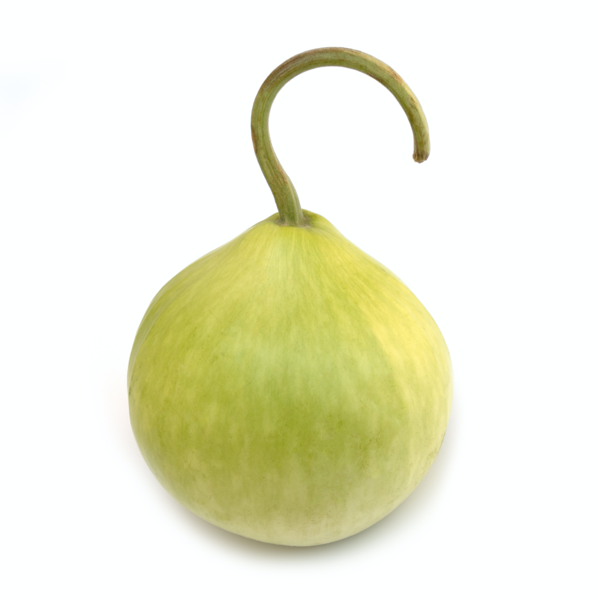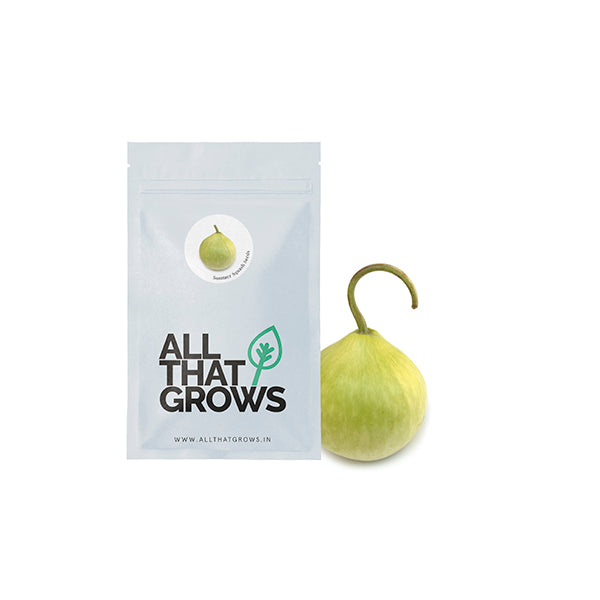



Summer Squash Seeds
Seed Type : Non-Hybrid, Open Pollinated and Non-GMO
Sowing time : February to March
Plants : Vigorous Veins
Fruit size : 80-100 gms
Fruit shape : Pure Round
Fruit color : Shinning yellowish green with faint green lines.
Flesh color : White
Specification : Skin surface hairy, heavy yielding
- SOWING
TIMEFeb - Mar
- Sowing
DistanceSEED TO SEED - 10'' LINE TO LINE -36''
- Fruit
Weight80-100 gms
- Fruit
ShapePure Round
- Days to
maturity60 - 90 days
- Details
- How to sow
- Reviews
Belonging to the easy-to-grow and healthy family of Cucurbitaceae, summer squashes are related to both the water-rich cucumber and the sweet melons! Not endowed with a very powerful taste such as the melon, the chappan kadu is more of a power-food than a tasty food. It's a variety of Zucchini, actually. They were originally found in the caves of Mexico about 10,000 years ago! Since then they are now found in almost all around the world with India, China, Russia, and the United States being the largest producers of the summer squashes. Summer squashes have a white soft flesh which and a very soft shell which is also edible. They are a rich source of carotenoids, minerals, good carbohydrates, anti-oxidants. They are also abundant in Vitamin C, K, phosphorus, potassium, Vitamin B6, B1, Zinc, Copper, Omega-3 fatty acids, folate and other essential nutrients. These essentials make the Chappan Kadu anti-microbial, anti-inflammatory, anti-cancer, and great for diabetic patients.
You can steam, boil, blanche, cook the summer squash for a curry-based dish or eat them raw. Some also add the summer squashes to soups, smoothies, and chutneys. So don't wait up, add this healthful vegetable to your green patch, right away!
Planting instructions
Sow summer squash seeds in prepared beds or hills in the springtime after the risk of frost is not there anymore.
You can also sow seeds indoors under fluorescent lights and then put out the seedlings when they are 3 weeks old.
You can sidestep early-season squash bugs by delaying the planting of seedlings until early summer.
Growing Requirements
watering
Squashes require a lot of watering during the hot weather. The soil needs to be moist 4 inches down.
pests
The following pests affect summer squash most commonly -Squash bugs, Squash vine borers, Cucumber beetles. The above mentioned pests can cause the following symptoms - Plants can be eaten or cut off near the soil level; Holes in leaves and flowers; tunnels in vines and fruit holes in stems near the base of plant; Mottled, distorted leaves etc.
soil
A well-drained loamy soil with a pH between 6.0 and 6.5 for growing.
spot
Summer Squash prefers a sunny site.
temperature
Summer squashes grow best in air temperatures ranging from 15° to 24° [60° to 75°F].
how to harvest
Summer squash harvest fruits from baby-sized up until they toughen with age.
Harvest at least twice a week, using a sharp knife to cut fruits (leave a little stub of stem attached).
Promptly wash fruits in cool water and store in the icebox.
For long-term storage, freeze or dry blanched pieces of summer squash.

Customer Reviews
The productiveness of any seed we sell is subject to your local climatic conditions*, the sowing method you adopt, and your commitment to the planting process. We give no warranty, expressed or implied, and are in no way responsible for the produce.
Please note that all our seasonal recommendations/ sowing information is as per the local climatic conditions. *For more information on the optimum conditions required for growing seeds in your region, please contact us at, hello@allthatgrows.in or Whatsapp us at, +91 8544865077
Questions & Answers
Have a Question?
Be the first to ask a question about this.




Summer Squash Seeds
Seed Type : Non-Hybrid, Open Pollinated and Non-GMO
Sowing time : February to March
Plants : Vigorous Veins
Fruit size : 80-100 gms
Fruit shape : Pure Round
Fruit color : Shinning yellowish green with faint green lines.
Flesh color : White
Specification : Skin surface hairy, heavy yielding
Belonging to the easy-to-grow and healthy family of Cucurbitaceae, summer squashes are related to both the water-rich cucumber and the sweet melons! Not endowed with a very powerful taste such as the melon, the chappan kadu is more of a power-food than a tasty food. It's a variety of Zucchini, actually. They were originally found in the caves of Mexico about 10,000 years ago! Since then they are now found in almost all around the world with India, China, Russia, and the United States being the largest producers of the summer squashes. Summer squashes have a white soft flesh which and a very soft shell which is also edible. They are a rich source of carotenoids, minerals, good carbohydrates, anti-oxidants. They are also abundant in Vitamin C, K, phosphorus, potassium, Vitamin B6, B1, Zinc, Copper, Omega-3 fatty acids, folate and other essential nutrients. These essentials make the Chappan Kadu anti-microbial, anti-inflammatory, anti-cancer, and great for diabetic patients.
You can steam, boil, blanche, cook the summer squash for a curry-based dish or eat them raw. Some also add the summer squashes to soups, smoothies, and chutneys. So don't wait up, add this healthful vegetable to your green patch, right away!
Seed Type : Non-Hybrid, Open Pollinated and Non-GMO
Sowing time : February to March
Plants : Vigorous Veins
Fruit size : 80-100 gms
Fruit shape : Pure Round
Fruit color : Shinning yellowish green with faint green lines.
Flesh color : White
Specification : Skin surface hairy, heavy yielding
- SOWING
TIMEFeb - Mar
- Sowing
DistanceSEED TO SEED - 10'' LINE TO LINE -36''
- Fruit
Weight80-100 gms
- Fruit
ShapePure Round
- Days to
maturity60 - 90 days
Planting instructions
Sow summer squash seeds in prepared beds or hills in the springtime after the risk of frost is not there anymore.
You can also sow seeds indoors under fluorescent lights and then put out the seedlings when they are 3 weeks old.
You can sidestep early-season squash bugs by delaying the planting of seedlings until early summer.
Growing Requirements
watering
Squashes require a lot of watering during the hot weather. The soil needs to be moist 4 inches down.
pests
The following pests affect summer squash most commonly -Squash bugs, Squash vine borers, Cucumber beetles. The above mentioned pests can cause the following symptoms - Plants can be eaten or cut off near the soil level; Holes in leaves and flowers; tunnels in vines and fruit holes in stems near the base of plant; Mottled, distorted leaves etc.
soil
A well-drained loamy soil with a pH between 6.0 and 6.5 for growing.
spot
Summer Squash prefers a sunny site.
temperature
Summer squashes grow best in air temperatures ranging from 15° to 24° [60° to 75°F].
how to harvest
Summer squash harvest fruits from baby-sized up until they toughen with age.
Harvest at least twice a week, using a sharp knife to cut fruits (leave a little stub of stem attached).
Promptly wash fruits in cool water and store in the icebox.
For long-term storage, freeze or dry blanched pieces of summer squash.



 Sign In
Sign In








